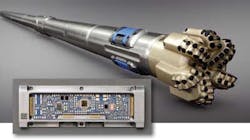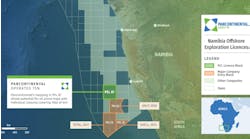View Article as Single page
Weatherford
In the Middle East Tinat field, the use of the Revolution RSS saved the company's client $350,000 and a week of drill time by eliminating the need for drill pipe-conveyed wireline tough-logging-condition (TLC) operations.
Tasked with drilling a 5-in. horizontal section out of a 7-in. cement float and shoe to reach total depth in one run, Weatherford engineers recommended the penta-combo 4¾-in. LWD tool string featuring the SpectralWave azimuthal gamma ray and CrossWave azimuthal sonic tools. These services were used for data on formation porosity and for advanced elemental and petrophysical analysis of the reservoir. First, a full torque-and-drag hydraulic analysis was performed in order to design a BHA to eliminate TLC and optimize the rate of penetration (ROP). Then the LWD string was designed to acquire all the reservoir and geosteering data requested by the operator.
The entire 1,456-ft (444-m) lateral section was drilled to a 17,059-ft (5,200-m) TD in a single run, while averaging 41 ft-12 m/hr ROP at approximately 250°F (121.1°C). The DownLink Commander was used for rapid, two-way communication with the BHA and the Revolution RSS for higher ROP and a smoother borehole.
Schlumberger
To tackle the growing number of high-pressure/high-temperature (HP/HT) wells, Schlumberger has developed an entire new tool system. Its name is ICE, ultra-high-temperature drilling services. ICE stands for Integrated Ceramic Electronics. This name is assigned to the new PowerDrive ICE RSS and the Telescope ICE high-speed telemetry service, but there is nothing cool about its record-breaking temperature capability. The system's operating temperature has been certified to 392°F (200°C) at pressures of 30,000 psi (207 bar) for 2,000 hours without failure.
Tested in the GoM and the Gulf of Thailand, where some of the hottest wells on the planet exist, the tool achieved its chief design criteria – uninterrupted drilling processes and provision of all required services. Testing included thermal shock cycling over a range of -72°F (-40°C) through 392°F (200°C). ICE electronic components use reliable ultra-high temperature multichip modules which include a ceramic substrate. The PowerDrive ICE dynamic elastomeric seals have been completely replaced by metal-to-metal ones.
The TeleScope ICE provides azimuthal gamma ray for steering, direction and inclination sensors, four-axis vibration, pressure, and temperature with two-way mud-pulse telemetry. Both the MWD and RSS tools are turbine powered and contain no batteries. The RSS tool operates up to 350 rpm for maximum ROP. The temperature rating applies to the system itself, not the formation temperature; thus it can successfully negotiate formations hotter than its rated temperature.
On its debut in Mexico, the PowerDrive ICE RSS saved nine days of rig time, conservatively valued at $1.35 million. This achievement was enhanced by a 16% ROP improvement drilling the well's 8½-in. tangent section over ROPs experienced in offset wells. The borehole trajectory steered from 77° to 57° azimuth to reach the 3D target set by PEMEX. Bottomhole conditions exceeded 329°F (165°C) and pressures greater than 15,000 psi (1,034 bar).
Originally, the operator experienced issues maintaining trajectory with a packed BHA. The pipe was tripped and the PowerDrive ICE RSS was deployed to recover the tangent section and withstand the high formation temperatures.
In Thailand, PTTEP drills more than 50 gas wells per year with BHT's greater than 200°C. Using the TeleScope ICE service, the operator was able to drill and steer successfully to target depth with measured formation temperatures of 399°F (204°C). A 13% rig time saving was achieved.




